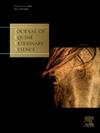Influence of ozonized autohemotherapy at acupuncture points on stallion sperm quality
IF 1.3
3区 农林科学
Q2 VETERINARY SCIENCES
引用次数: 0
Abstract
It is estimated that 30-40% of stallions in commercial breeding programs are moderately fertile and at least 8-12% are subfertile. Within the latter category, 0.5-3% suffer from severe subfertility (pregnancy rate of less than 10%/cycle). Oxidative stress is one of the main causes of sperm dysfunction and male infertility, negatively affecting the structure and function integrity of sperm. Autologous blood injection is an empirical treatment technique for autoimmune or inflammatory diseases. In acupuncture, hemotherapy or hemopuncture has been performed on specific points such as Be23, Be26, Bai Hui, P1, thyroid, etc. to potentiate the effects of acupuncture. Ozone therapy is a complementary therapy technique that uses a mixture of oxygen and ozone (95%-99.95% oxygen and 0.05%-5% ozone). The therapeutic window varies in concentrations from 10 to 60μg/ml. It produces immunomodulation, analgesia, anti-inflammatory, bactericidal, antiviral, and antifungal effects. The effects produced by O3 are due to its mechanism of action which stems from moderate and transient oxidative stress, which induces the activation of second messengers such as nuclear factor erythroid 2 (Nrf2) and lipid peroxidation products such as malondialdehyde and 4-hydroxynonenal, which will increase the synthesis of different antioxidant enzymes with a consequent increase in the body's total antioxidant capacity. In this context, this study aimed to evaluate the effect of blood therapy with ozone administered by different routes in a stallion with poor seminal quality, to later assess its influence on sperm motility, vigor, concentration, volume, and pathology. A stallion with poor semen quality was used and 5 semen samples were collected every two days, with average parameters of motility 31%, vigor 3, volume 38.4ml, concentration 120 × 106/ml, and sperm pathologies with 10% of major defects and 8% of minor defects. The semen was diluted 1:1 with Botusêmen with an average of 48% motility, and vigor 3. The treatment began with 10 ml of blood and 10 ml of O3 at 50 mcg/mL in a 20mL syringe and with 60 sucking movements before application to the Lung and Thyroid points, and 20 ml of gas at 8mcg/mL in the subcutaneous tissue in the scrotum. The treatment was carried out every 2 days with 8 applications. After the third application, semen was collected every 2 days for 5 days. The average parameters were motility 78%, vigor 4, volume 33.2ml, concentration 147 × 106/ml. After the 1:1 dilution, the parameters did not change. All the evaluations were carried out via iSPERM and there was no change in sperm pathology. After treatment, there was a statistical difference in motility (p=0.001) and no difference in concentration (p=0.19) (ANOVA). We conclude that ozone can be used in stallions with low sperm motility.
求助全文
约1分钟内获得全文
求助全文
来源期刊

Journal of Equine Veterinary Science
农林科学-兽医学
CiteScore
2.70
自引率
7.70%
发文量
249
审稿时长
77 days
期刊介绍:
Journal of Equine Veterinary Science (JEVS) is an international publication designed for the practicing equine veterinarian, equine researcher, and other equine health care specialist. Published monthly, each issue of JEVS includes original research, reviews, case reports, short communications, and clinical techniques from leaders in the equine veterinary field, covering such topics as laminitis, reproduction, infectious disease, parasitology, behavior, podology, internal medicine, surgery and nutrition.
 求助内容:
求助内容: 应助结果提醒方式:
应助结果提醒方式:


